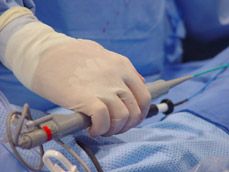Contact Force Sensing Increases Atrial Fibrillation Treatment for Some
New research indicates that contact force sensing technology increases the effectiveness of catheter ablations among patients with paroxysmal atrial fibrillation (AF) - but not among patients with non-paroxysmal AF.

New research indicates that contact force sensing (CFS) technology increases the effectiveness of catheter ablations among patients with paroxysmal atrial fibrillation (AF) — but not among patients with non-paroxysmal AF.
The study, which appears in the Journal of Cardiovascular Electrophysiology, compared 200 first-time ablations that used CFS technology with 400 standard ablations on comparable patients.
All of the operations took place between 2010 and 2012 on patients with differing degrees of AF: 46% paroxysmal, 36% persistent, 18% long-lasting persistent.
Mean follow-up time was 11.4 ± 4.7 months for all patients, though numbers varied slightly among the different subgroups. Among patients with paroxysmal AF, mean follow-up time was 11.2 ± 4.1 months in the CFS group and 11.3 ± 3.9 months in the control group (p = 0.745). Among patients with non-paroxysmal AF, mean follow-up time was 10.4 ± 4.5 months in the CFS group and 11.9 ± 5.4 months in the control group (p = 0.015).
The researchers used the data to test the impact of 19 different factors on ablation success, and they attempted to control for all of the relevant ones when measuring the effect of CFS technology. Still, they found a substantial effect.
For patients with paroxysmal AF, the use of a CFS catheter more than doubled the chances that ablation would keep their hearts beating properly throughout the follow-up period (hazard ratio [HR], 2.24; 95% confidence interval [CI], 1.29—3.90; p = 0.004).
For patients with non-paroxysmal AF, however, the story was completely different. Multivariate analysis found that CFS technology increased the chances of failure, though not to a significant extent (HR, 0.73; 95% CI, 0.41—1.30; p = 0.289).
CFS technology did, however, have a significant advantage for all types of patients, reduced fluoroscopy time. The study team’s analysis showed that contact force sensors reduced the time that patients were exposed to imaging machines by an average of 7.7 minutes (95% CI, 5.0—10.5 minutes; p < 0.001).
Complication rates, on the other hand, were comparable across all patient groups no matter what technology was used.
Several other studies have found that CFS technology can improve ablation success rates, particularly when contact force remains at recommended levels throughout the procedure. Indeed, a recent paper in the Journal of the American College of Cardiology found that ablations performed with one device were 4.25 times more likely to succeed when doctors applied appropriate force at least 80% of the time (95% CI, 1.53-11.79; p = 0.0054).
During catheter ablation, doctors insert a catheter through a small incision in the groin and push it up a blood vessel to the upper-left chamber of the heart. They then use radiofrequency energy to create lesions and block the faulty electrical impulses that can cause heart rhythm disorders.
Excess contact between the catheter tip and the heart can result in tissue injuries and complications, while insufficient contact can prevent doctors from forming complete lesions and blocking the electrical impulses.
Traditional ablation technology forces doctors to estimate the strength of contact between catheter tip and heart via indirect measures such as electrogram parameters and impedance.
Contact force sensors were developed to reduce mistakes by providing real feedback in real time. More studies are underway to evaluate the technology, but the authors of the most recent paper feel their findings were strong enough to conclude that CFS improves outcomes for patients with paroxysmal AF.